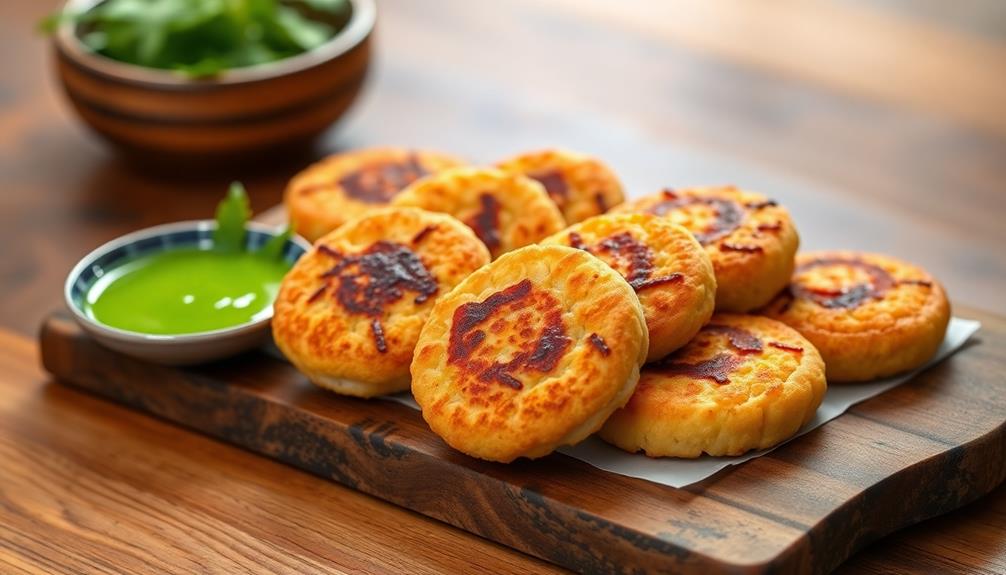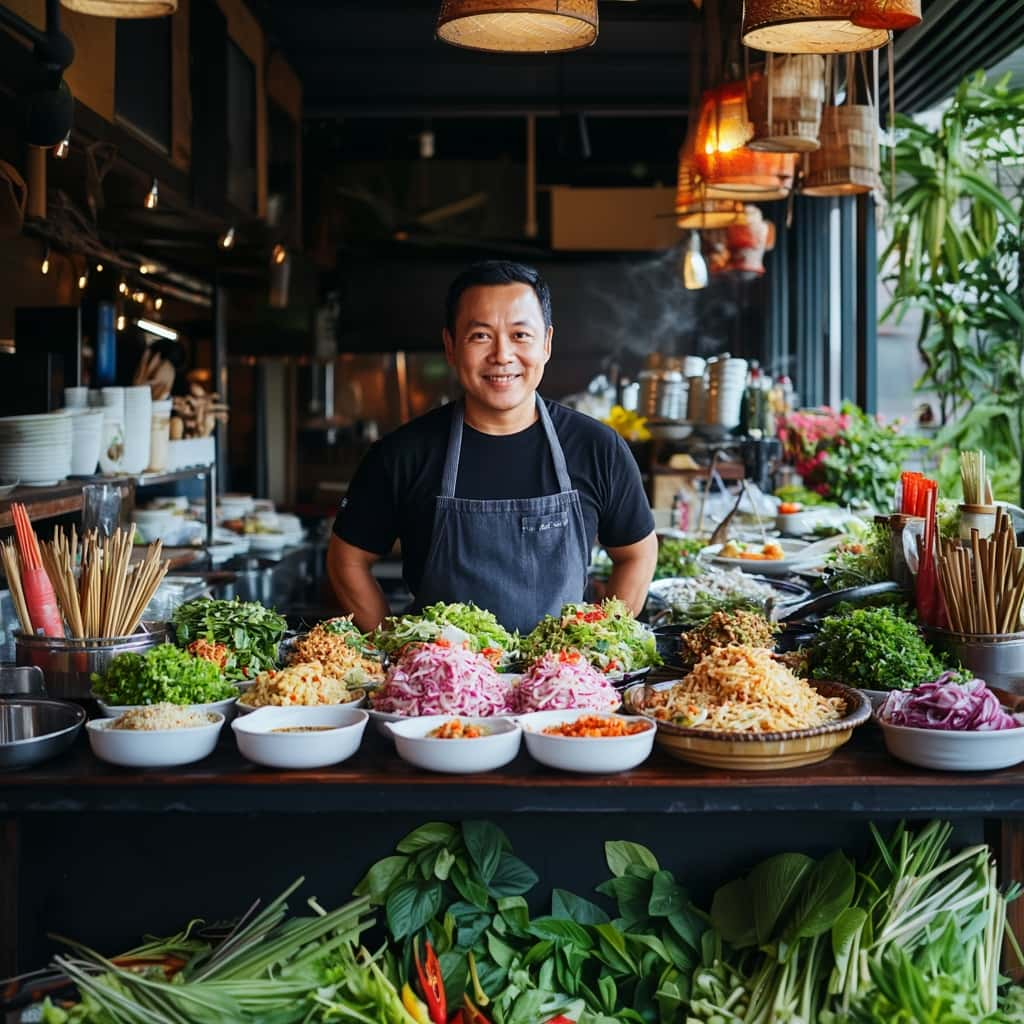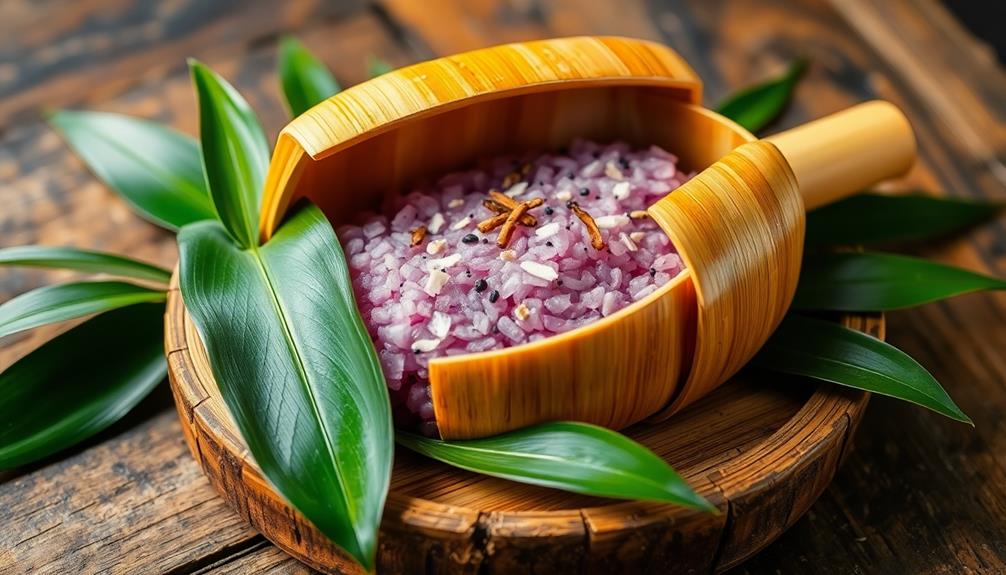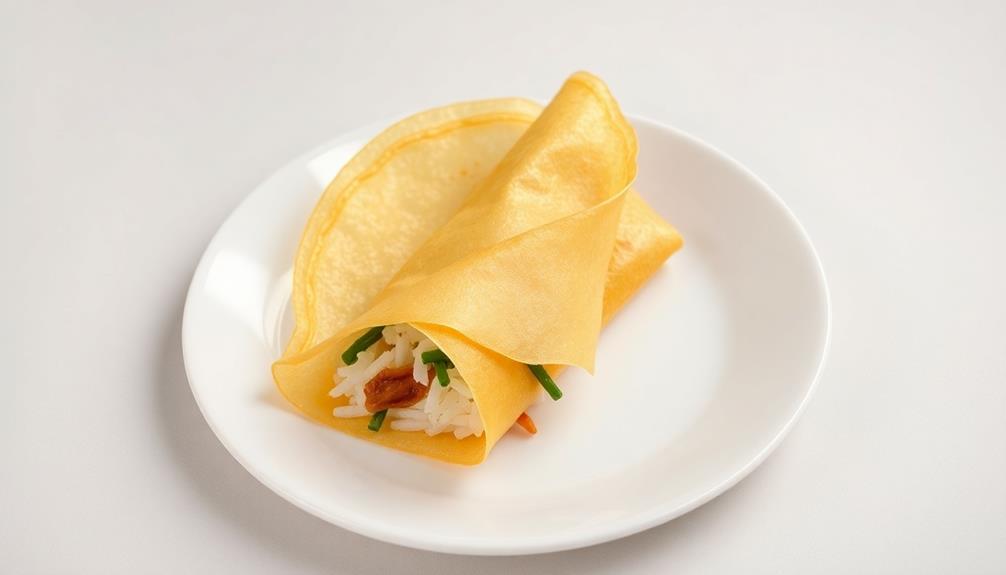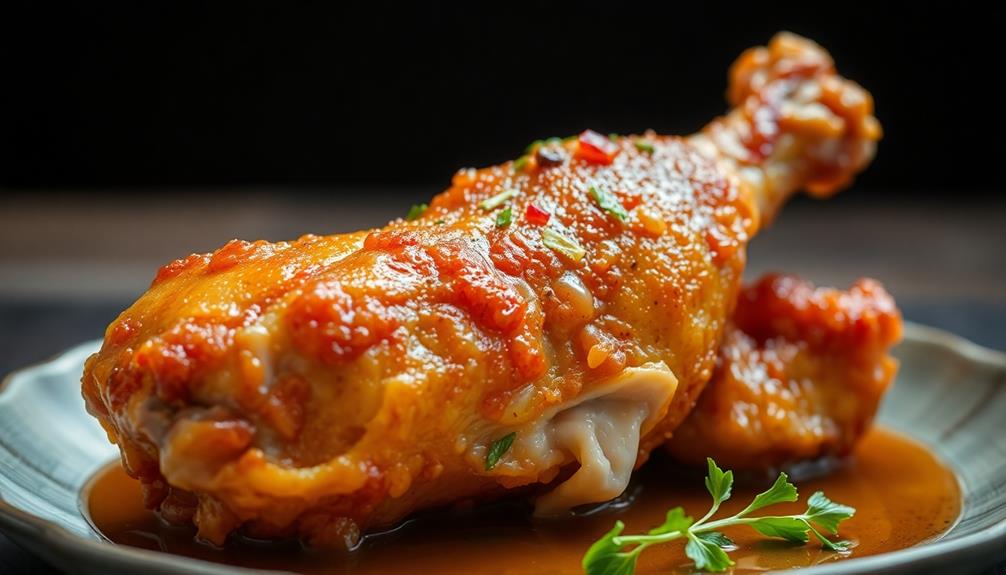Tod Mun Pla, the beloved Thai fish cakes, have captivated taste buds for centuries. Originating from coastal regions, this crisp and flavorful dish blends savory, sweet, and spicy notes, showcasing the vibrant food culture of Thailand. You'll need fresh white fish, herbs, and spices to recreate this authentic street food at home. Carefully mix the ingredients, form into patties, and deep-fry until golden brown. Serve warm with a flavorful dipping sauce for the ultimate experience. Mastering Tod Mun Pla opens the door to exploring the artistry and balance of Thai cuisine – let's dive in further.
Key Takeaways
- Tod Mun Pla is a traditional Thai dish with origins traced to coastal regions, reflecting the rich culinary heritage of Thailand.
- It is known for its crispy texture and a blend of savory, sweet, and spicy flavors, typically made from fresh fish, herbs, and spices.
- The dish is often enjoyed during festivals and special occasions, emphasizing the cultural significance of communal dining in Thai cuisine.
- Key ingredients include fresh white fish, long beans, Thai basil, lemongrass, fish sauce, and red curry paste.
- Mastering Tod Mun Pla involves skillful preparation techniques, such as balancing flavors and achieving the ideal texture through proper frying.
History
According to historical records, Tod Mun Pla's origins can be traced back to the coastal regions of Thailand. This beloved fish cake dish has been a staple in Thai cuisine for centuries, with recipes and techniques passed down through generations.
The name "Tod Mun Pla" translates to "fried fish cakes," reflecting the dish's key components – a blend of fresh fish, herbs, and spices that are formed into patties and then deep-fried to golden perfection.
Originally, coastal communities would use locally caught fish, such as mackerel or tilapia, to make these flavorful cakes.
Over time, the recipe has evolved, with variations emerging across different regions of Thailand. Some versions incorporate ingredients like kaffir lime leaves, red curry paste, or even shrimp, adding unique twists to the classic dish.
Regardless of the specific ingredients, Tod Mun Pla remains a beloved staple, cherished for its perfect balance of crispy exterior and tender, flavorful interior.
Recipe
Tod Mun Pla is a classic Thai fish cake dish that's beloved for its delightful blend of flavors and textures. These savory cakes are made with a combination of freshly caught fish, aromatic herbs, and a hint of spice, resulting in a truly delectable snack or appetizer.
The key to crafting the perfect Tod Mun Pla lies in the careful selection and preparation of the ingredients. By following this recipe, you can recreate the authentic taste of this Thai street food classic in your own kitchen.
Ingredients:
- 1 lb fresh white fish (such as tilapia or catfish), finely chopped
- 1 cup finely chopped long beans or green beans
- 1/2 cup finely chopped Thai basil leaves
- 1/4 cup finely chopped lemongrass, tender white parts only
- 2 tablespoons fish sauce
- 1 tablespoon red curry paste
- 1 teaspoon sugar
- 1 egg, beaten
- 1/4 cup all-purpose flour
- Vegetable oil for frying
Instructions:
In a large bowl, combine the chopped fish, long beans, Thai basil, lemongrass, fish sauce, red curry paste, and sugar. Mix well until the ingredients are evenly distributed.
Gently fold in the beaten egg and all-purpose flour until a cohesive mixture forms.
Heat a generous amount of vegetable oil in a large skillet over medium-high heat. Scoop heaping tablespoons of the fish mixture and gently drop them into the hot oil.
Fry the Tod Mun Pla for 2-3 minutes per side, or until they're golden brown and crispy. Drain the cooked fish cakes on a paper towel-lined plate.
Tips:
For the best texture, be sure not to overmix the fish mixture. Gently folding in the ingredients will help to maintain the delicate, flaky texture of the fish cakes.
Additionally, it's important to work in small batches when frying to ensure even cooking. Serve the Tod Mun Pla hot, accompanied by a tangy dipping sauce of your choice, such as a sweet chili sauce or a spicy-sour tamarind sauce.
Cooking Steps
Mix the fresh fish with a bit of flour to create uniform patties.
Then, gently fry the patties in hot oil until they're golden brown.
Drain the fried patties on paper towels, and serve them warm with a delicious dipping sauce on the side.
Step 1. Mix Fish With Flour
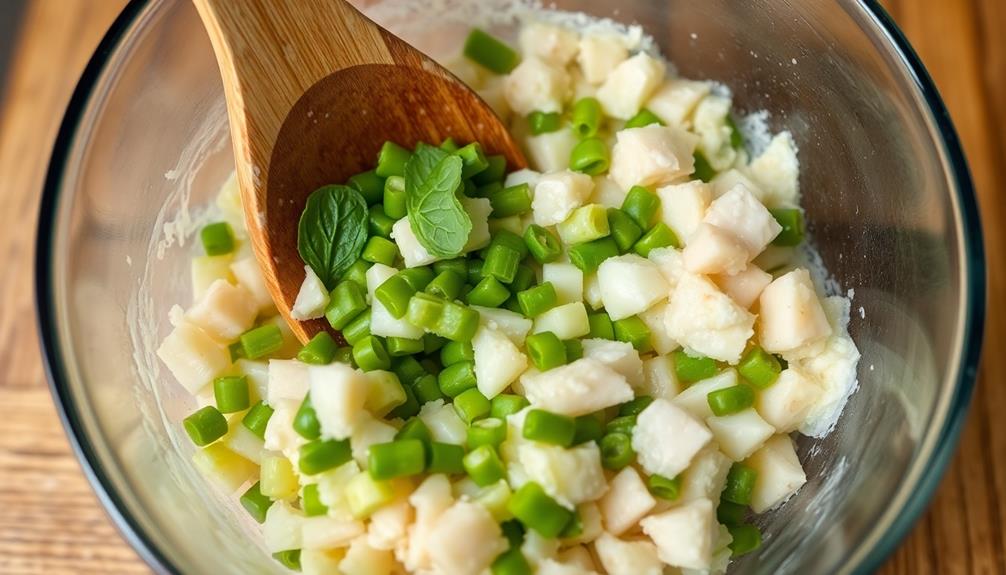
Take the fresh fish fillets and gently pat them dry with a clean paper towel.
Grab a large mixing bowl and add the fish. Using clean hands, break up the fish into small pieces, ensuring an even consistency.
Next, sprinkle in a generous amount of all-purpose flour. Begin gently mixing the fish and flour together, working the ingredients until they're fully incorporated.
You'll want to create a thick, somewhat sticky mixture that holds its shape. Be careful not to overmix, as this can result in tough, dense fish cakes.
Once the fish and flour are well combined, you're ready to form the mixture into patties or balls, depending on your desired shape.
Gently shape the mixture with your hands, taking care not to pack it too tightly.
Now you've successfully mixed the fish with the flour, laying the foundation for the next steps in creating delicious Tod Mun Pla!
Step 2. Form Into Patties

With the fish and flour mixture ready, you can now start forming it into patties. Scoop up a palm-sized amount of the mixture and gently shape it into a round, flattened patty. Be careful not to squeeze too hard, as you want the patties to have a delicate, tender texture.
Once you've formed the patty, place it on a clean surface or plate. Repeat this process, making sure to keep the patties evenly sized for even cooking. If the mixture starts to stick to your hands, you can lightly wet them with water to prevent it.
When all the patties are formed, you're ready to move on to the next step of cooking the tod mun pla. The key is to handle the delicate fish mixture gently, shaping it into perfectly portioned patties that will fry up crispy on the outside and moist on the inside.
With a little care, you'll have a plate of beautifully shaped fish cakes ready for the next phase of the recipe.
Step 3. Fry Patties in Hot Oil
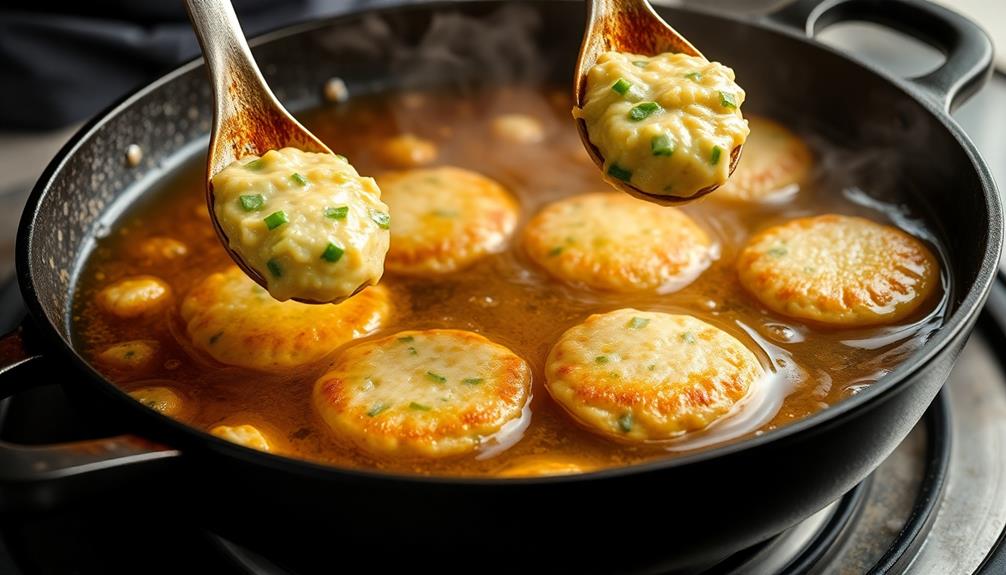
To start cooking the tod mun pla, heat a generous amount of oil in a large skillet or frying pan over medium-high heat.
Once the oil is hot, carefully add the prepared patties, making sure not to overcrowd the pan. Fry the patties for 2-3 minutes per side, or until they're golden brown and crispy. Be cautious, as the hot oil can cause splattering.
After the first side is nicely browned, flip the patties using a slotted spoon or tongs. Fry the other side until it also develops a crisp, golden-brown crust.
Keep an eye on the patties, adjusting the heat as needed to prevent burning. When both sides are perfectly fried, transfer the crispy tod mun pla to a paper towel-lined plate to drain any excess oil.
Repeat the process in batches until all the patties are beautifully fried. Serve the tod mun pla hot, garnished with fresh herbs or a dipping sauce of your choice.
Enjoy the delightful crunch and flavor of this authentic Thai street food.
Step 4. Drain Fried Patties on Paper Towel

After frying the tod mun pla patties to a crisp golden-brown, you'll want to drain them on a paper towel-lined plate. This step is crucial for removing any excess oil, ensuring your fish cakes have a delightfully crispy exterior without feeling greasy.
Gently place the fried patties in a single layer on the paper towels, allowing the absorbent material to soak up any lingering oil. This not only enhances the texture but also helps to prevent sogginess.
Take care not to stack the patties, as this can trap moisture and lead to a less desirable result. Once drained, your tod mun pla are ready to be served hot, garnished with fresh herbs, chili, or your favorite dipping sauce.
The paper towel method ensures your homemade fish cakes maintain their perfect crunch and flavor, making them an irresistible appetizer or side dish.
Step 5. Serve Warm With Dipping Sauce
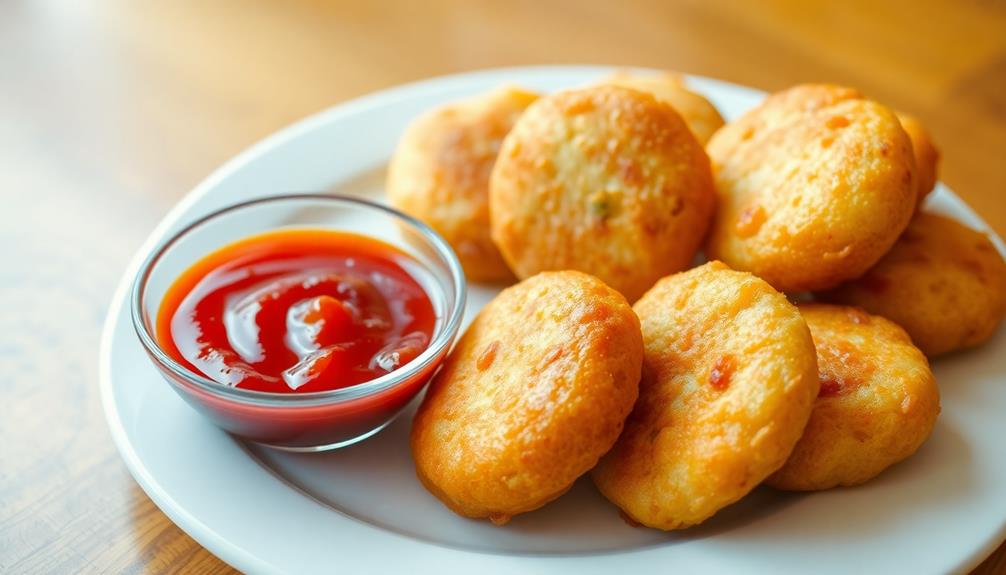
Once the crisp tod mun pla patties have been drained on paper towels, it's time to serve them warm with a delectable dipping sauce.
You'll want to present the fish cakes hot, as the contrast of the crispy exterior and the tender, flavorful interior is simply divine when they're freshly fried.
Prepare your favorite dipping sauce, whether it's a sweet chili sauce, a tangy tamarind dip, or a creamy coconut-based condiment.
Arrange the hot tod mun pla on a serving platter and place the sauce in a small bowl alongside. Encourage your guests to dip the fish cakes into the sauce, allowing the flavors to mingle and complement each other.
The warmth of the patties, combined with the zesty or creamy dipping sauce, creates a truly irresistible flavor experience.
Serve the tod mun pla immediately for the best texture and taste. Your guests will be delighted by the fragrant, satisfying combination of the crispy fish cakes and the flavorful dipping sauce. If you’re looking for an additional dish to complement your tod mun pla, consider trying our hoy tod recipe as well. The crispy oyster fritters are sure to be a hit with your guests and add even more variety to your menu. Don’t forget to pair them with a tangy and spicy dipping sauce for the perfect finish to your meal.
Final Thoughts
Reflecting on the captivating culinary adventure that's Tod Mun Pla, you're left with an appreciation for the depth of flavor and cultural significance within this iconic Thai dish.
The perfect balance of savory, sweet, and spicy notes in the fish cakes is a testament to the skill and care put into their preparation. As you savor the final bites, you can't help but feel a sense of connection to the rich traditions of Thai cuisine.
Ultimately, Tod Mun Pla is more than just a delicious snack – it's a window into the vibrant flavors and traditions of Thai culture.
Whether you're an experienced cook or a newcomer to Thai food, mastering this dish is a rewarding journey that will leave you with a newfound respect for the culinary artistry of Thailand.
Frequently Asked Questions
Where Can I Find Tod Mun Pla in the United States?
You can find this Thai dish in many Asian grocery stores or specialty markets across the United States. Look for it in the freezer section or prepared food areas of these stores.
How Long Do Tod Mun Pla Last in the Refrigerator?
How long do the fish cakes last in the fridge? With proper storage, they'll keep for 3-4 days. Make sure to store them in an airtight container and consume them within that timeframe for the best quality and freshness.
Can I Use a Different Type of Fish for Tod Mun Pla?
You can absolutely use a different type of fish for your dish. The key is to choose a firm, white fish that will hold its shape during the frying process. Feel free to experiment with your favorite fish varieties.
Is Tod Mun Pla Gluten-Free?
Yes, tod mun pla can be gluten-free. You'll need to check the ingredients, as some recipes may include wheat flour or breadcrumbs. But you can easily make a gluten-free version using alternative flours or binding agents.
What Is the Best Dipping Sauce for Tod Mun Pla?
The best dipping sauce for this Thai dish is likely a sweet and sour sauce. You can easily make one at home with a blend of fish sauce, lime juice, sugar, and chili peppers.
